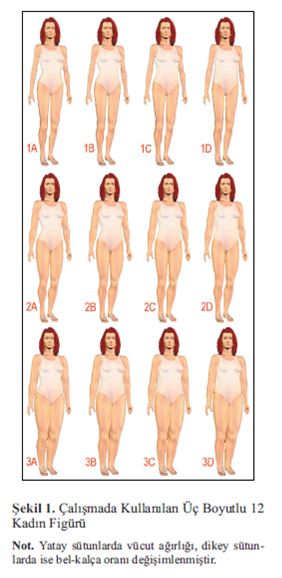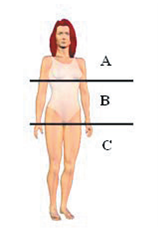Archive
Another Eye Tracking Study of Female Body Attractiveness
Seda Dural et.al. (2008) used eye tracking combined with attractiveness ratings to explore the effect of altering waist-hip ratio and body fat levels in figures generated from 3D modeling software.

The stimuli were presented individually to 50 males and 50 females aged 18-22 (probably Turkish college students) on an LCD screen for viewing and rated for attractiveness while eye movements were tracked using, what seems to be, in-lab created eye tracking hardware. (The article is published in Turkish and I have been forced to rely on the English language summary combined with obscure, computer-generated translations of sections of the full text.) That being said, the stimuli are very similar to those used in Singh’s original studies, though more detail and dimensionality are visible. Attractiveness ratings data are contained in this chart:

For eye tracking analysis, the authors divided the figures into 3 areas:

and used eye tracking data from the most and least attractive stimuli and found that raters looked more often at area B than at areas A and C in both the most and least attractive stimulus figures. The authors conclude that their study provides significant support for the role of waist-hip ratio in the evaluation of female body attractiveness.
Strengths:
- Utilized 3D software to generate stimulus figures
- Utilized eye tracking data
- Non-U.S. college student sample
Cautions:
- Considering that there is: minimal variation in section A across the 3 weight categories; minimal variation in section C within weight categories; and the most variation between all stimuli in section B; it is possible that the subjects in this study learned that section B contained the most variable information in the stimuli and that section B viewing frequencies are an artifact of the experimental controls themselves
- As the table above shows (labeled Sekel 5), normal body weight images were significantly more attractive than either under or over weight images
- Eye fixations in section B do not necessarily indicate that attention is being directed to waist-hip ratio (Cornelissen, 2009)
All-in-all, this study further confirms that both total body fat and body fat distribution as revealed in the WHR are components of female body attractiveness. The eye tracking data, however, do not support the assertion that WHR is the primary determinant of body attractiveness in women.
Wayne Hooke
![]() Dural, Seda, Cetinkaya, Hakan, Gulbetekin, Evrim (2008). The role of waist-to-hip ratio in evaluation of female physical attractiveness: Eye-tracker data.
Dural, Seda, Cetinkaya, Hakan, Gulbetekin, Evrim (2008). The role of waist-to-hip ratio in evaluation of female physical attractiveness: Eye-tracker data.
Kadinin fiziksel cekiciliinin deerlendirilmesinde bel-kalca-oraninin rolu: Goz-izleme sistemi verileri. Turk Psikoloji Dergisi, 23(61), 75-88
What is the Evidence for the Good Genes Hypothesis?
Introductions and conclusions to many contemporary research studies on the psychology of beauty include some reference to the data supporting the good genes hypothesis. Briefly, the good genes hypothesis asserts that an animal is attracted to some feature in the other sex because that feature indicates that the possessor carries good genes. According to Jerry Coyne, in Why Evolution is True, there are only two studies to date that directly support this assertion: one involving gray tree frogs and the other involving peafowl. Additionally, he reports that many studies have failed to find support for the good genes hypothesis.
While the good genes hypothesis remains the preferred – but mostly unsubstantiated – hypothesis in many cases of elaborate, sexually dimorphic traits it is premature to overemphasize the explanation in research on human beauty. I believe academic rigor calls for more cautious and tentative explanations for human beauty data.
Wayne Hooke
Beauty is in the Eye Movements of the Beholder
An ongoing debate today is the relative contribution of total body fat and waist-hip ratio to evaluations of female body attractiveness. Converging research has tended to support a more significant role for total body fat (as measured by BMI or VHI) than for WHR. Using a novel eye tracking methodology, Cornelissen, et.al. (2009) have found that eye movements made during evaluations of body attractiveness are more similar to eye movements made when assessing total body fat rather than to those made when assessing waist-hip ratio.

Figure 1 The left and central columns of bodies show contour plots of the fixation distributions for the attractiveness (ATT), body fat (FAT) and WHR estimation conditions for both genders overlaid onto the image of the reference body. In order to facilitate inspection of the data across all conditions, fixation density in the left and central columns has been converted to a percentage score, indicated by colour bars (0-100), with red indicating the highest density. The right column of bodies shows the differences in the fixation density (i.e. differences in raw scores) between the genders for the three conditions. Positive differences are shown as red/yellow colours; negative differences are shown as blue/cyan colours. The black contours demarcate regions within which these differences are statistically significant as determined by the GLMMs. (Figure and description from: Cornelissen, p. 9)
Strengths
- Carefully mapped, high resolution eye tracking data was used.
Cautions
- Male evaluators minimally fixated on the edges of the torso when evaluating WHR. This is hard to make sense of.
- Methodology assumes that foveal detail is central in processing body attractiveness. While this seems likely, it remains possible that significant data is accessed in more peripheral visual areas. Foveal detail takes in approximately 2° of the visual field while the functional visual field varies from 4-90° (Murata: PMID: 15151160; or Questia Excerpt ) – in this study, hip width was reliably within the functional visual field when fixation was at the midpoint of the body (4-4.5°). Cornelissen et.al. provided a check for this potential confound by presenting the same stimuli to different evaluators, this time establishing that the focal point was in the center of the torso while presenting the image for only 100ms. Evaluators were not able to accurately estimate WHR or fWHR (the apparent WHR that is determined simply by using the 2 dimensions available to the evaluator in the photographic display). This check does provide support for the methodology used in the primary study, but some may not view this check as compelling.
- A Tobii 1750 Eye Tracker was used to track eye movements. The Tobii 1750 is accurate to 0.5°; drifts less than 1.0°; and has head movement compensation error of less than 1.0°. Assuming these errors are potentially additive, individual measurements could be off by no more than 2.5°. I have never used eye tracking technology and so have no expertise with it: but, the published accuracy parameters seem uncomfortably large when attempting to track eye movements across a 4.0-4.5° target field.
- Analysis was conducted on fixation density (a count of fixations on regions of the body) – no sequential analyses are reported in this publication (e.g.: waist → hip → breast → upper arm → waist).
- Optimal BMI/VHI ratios appear under represented and may not be present in the stimulus set. Average BMI was 22.3 (sd = 2.3).
- The mean WHR in this study is .74 (sd = .04) with a range of .64 – .84: we can estimate that 7-8 of the 46 stimulus images contained optimal or curvier waist lines. This preponderance of straighter waist lines could decrease visual interest in this area and might have influenced the outcome of the study.
This study provides further, substantive, converging evidence to support the relatively greater importance of total body fat over waist hip ratio in the evaluation of female body attractiveness. Suggestions for further research using eye movement tracking methodologies might include:
- Sequential analyses of eye movement data
- Utilization of stimulus images with dimensions that take-up significantly more than 4-4.5° of the visual field
- Utilization of more optimal/attractive stimulus images
- Utilize images that hold BMI/body fat constant, but still vary substantially in appearance
Wayne Hooke
![]()
Cornelissen, P., Hancock, P., Kiviniemi, V., George, H., & Tovée, M. (2009). Patterns of eye movements when male and female observers judge female attractiveness, body fat and waist-to-hip ratio Evolution and Human Behavior DOI: 10.1016/j.evolhumbehav.2009.04.003